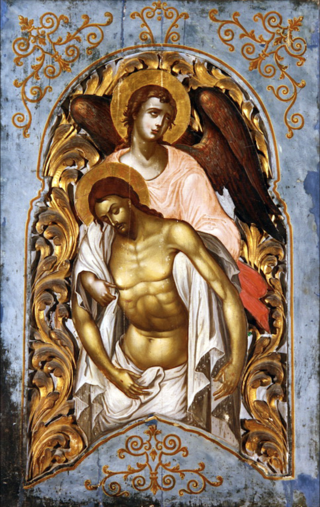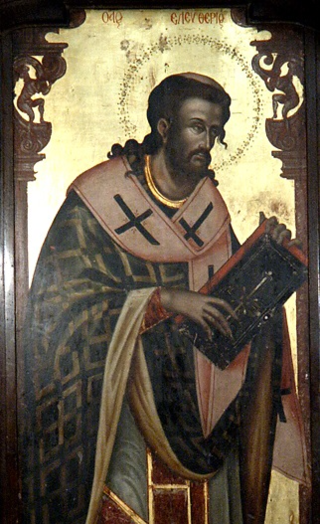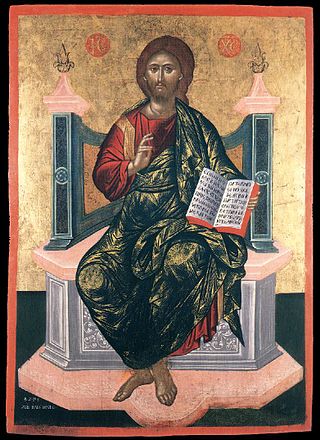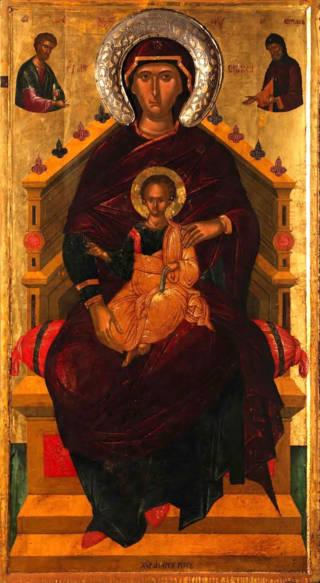
Belisario Corenzio was a Greek-Italian painter, active in Venice and Naples. He is one of few Greek painters that did not belong to the Cretan Renaissance like his contemporaries of the time. He escaped the maniera greca completely. He adopted the Venetian style. Other similar Greek painters were Marco Basaiti, Ioannis Permeniates, Antonio Vassilacchi and El Greco. He was sometimes referred to as Il Greco. His teacher was prominent Venetian painter Tintoretto. In 1590, at age 32 Corenzio settled in Naples. Corenzio was influenced by Cavalier d'Arpino. He continued to flourish in the region. His apprentices included: Luigi Rodriguez, Andrea di Leone, Onofrio De Lione and Massimo Stanzione. Corenzio painted many frescos that survived today. Some of his works are in the Church of San Severino and Certosa di San Martino. His style resembles Caravaggio. An Italian legend in Naples exists involving Corenzio, Spanish painter Jusepe de Ribera, and Battistello Caracciolo. They were referred to as the Cabal of Naples. The three painters were rumored to have poisoned their competition for painting contracts. The rumors lack documented evidence. The three painters were very popular in Naples. Corenzio frescoed the Crypt that holds the remains of Matthew the Apostle at Salerno Cathedral and it depicts scenes from the Gospel of Matthew. Corenzio was one of the most celebrated fresco painters in Naples during his time. His drawings can be found all over the world namely at the Metropolitan Museum, Museo di Capodimonte and Louvre. More recently, his life and work was studied by the Greek art historian Panayotis K. Ioannou in a comprehensive monograph.

The Heptanese school of painting succeeded the Cretan school as the leading school of Greek post-Byzantine painting after Crete fell to the Ottomans in 1669. Like the Cretan school, it combined Byzantine traditions with an increasing Western European artistic influence and also saw the first significant depiction of secular subjects. The school was based in the Ionian Islands, which were not part of Ottoman Greece, from the middle of the 17th century until the middle of the 19th century. The center of Greek art migrated urgently to the Ionian Islands but countless Greek artists were influenced by the school including the ones living throughout the Greek communities in the Ottoman Empire and elsewhere in the world.

San Giorgio dei Greci is a church in the sestiere (neighborhood) of Castello, Venice, northern Italy. It was the center of the Scuola dei Greci, the Confraternity of the Greeks in Venice. Around this period there was a similar church in Naples called Santi Pietro e Paolo dei Greci. There was also a Greek Brotherhood of Naples.

Emmanuel Tzanes, also known as BounialisEmmanuel Tzane-Bounialis, Emmanuel Zane, and Emmanuel Tzane, was a Greek Renaissance painter, author, clergyman, and educator. He spent the latter half of his life in Venice, where he was parish priest of the church of San Giorgio dei Greci and a member of the Flanginian School run by the city's Greek Confraternity. Tzanes painted in the style of the Cretan School, influenced by contemporary trends in Venetian painting. His known extant works, over 130 in number, can be found in public foundations, private collections, churches and monasteries in Greece. The most popular of these is The Holy Towel, finished in 1659. Tzanes was a collaborator with Philotheos Skoufos, and brothers with the painter Konstantinos Tzanes and the poet Marinos Tzanes.

Ilias or Elias Moskos was a Greek educator, shipping merchant and painter from Crete. The last name Moskos was associated with three famous painters of the Cretan School alive during the same period, along with Ioannis Moskos and Leos Moskos, possibly his relatives. Elias incorporated maniera greca with the Venetian style. Theodore Poulakis and Moskos brought the art and style of Crete into the Heptanese School of the Ionian Islands. Some of his work was inspired by Angelos Akotantos. He was affiliated with other artists such as Philotheos Skoufos. He is often confused with Leos Moskos. His son was not Ioannis Moskos although they were probably related. Elias most popular painting is Christ Pantocrator. Fifty-two of his paintings survived.

Nikolaos Kallergis, also known as Kalergis. He was a Greek painter during the Greek Rococo and the Modern Greek Enlightenment in art also known as Neo-Hellenikos Diafotismos. His art also exhibited Venetian influence. Painters of the maniera greca began to refine their art. Philotheos Skoufos, Elias Moskos, and Theodore Poulakis were all active painters on the Ionian Islands prior to Kallergis. They set the stage for the transition to the Heptanese School. Panagiotis Doxaras is the forefather of the new painting style. He was the father of Greek Rococo and the Modern Greek Enlightenment in painting. Kallergis became an active member of the school. Kallergis also represents the Greek Rococo. His art began to exhibit qualities of Greek and Italian Neoclassicism. His style influenced countless painters. Examples include Nikolaos Kantounis, Nikolaos Koutouzis, Nikolaos Doxaras, Spiridione Roma, and Eustathios Karousos. His most famous work is Christ and Angel it is at the Zakynthos Museum.

Spyridon Sperantzas was a Greek painter. He flourished during the Greek Neoclassical era and the Modern Greek Enlightenment in art also known as Neo-Hellenikos Diafotismos. Because of the Fall of the Republic of Venice, Sperantzas brought the Heptanese School into the Greek Romantic period. By the 1800s the Ionian Islands were occupied by both French and English forces and for the first time since the fall of the Byzantine Empire, the local Greeks governed themselves. Sperantzas, Nikolaos Kantounis, and Nikolaos Koutouzis represent the transition in painting that defined Modern Greek art. Sperantzas was influenced by Nikolaos Kallergis, Nikolaos Doxaras, and Nikolaos Koutouzis. His son Michael Sperantzas was also a famous painter and his apprentice. Spyridon also painted frescos.

Andreas Karantinos, also known as Andreas Karandinos. He was Greek Renaissance painter, educator and goldsmith. He was from Kefalonia. He was a member of the Heptanese School. His artwork is reflective of the time period. His teacher was famous painter Stephanos Tzangarolas. He adapted his style. Karandinos also emulated the Cretan masters such as Michael Damaskinos. Many Greek painters emulated one other. Karandinos also taught famous Greek painter Konstantinos Kokkinos and several others. Many of his works are in Greece mostly on the island of Kefalonia. Twenty two of his work survived and one fresco. The fresco is of the Second Coming or the Last Judgement. The fresco is located in the church of Evagelastria in Kastro Kefalonia.

Georgios Nomikos was a Greek painter. He converted to Christianity from Judaism. He was a Greek Baroque painter. He was a member of the Cretan school and the Heptanese (Ionian) school. His contemporaries were Georgios Kastrofylakas, Theodore Poulakis, and Georgios Markou. He shared the same last name with famous Greek painter Demetrios Nomikos. He was active on the island of Zakynthos, Kefalonia Arta and Ioannina. Six of his paintings survived. Some of his frescos have survived in the destroyed church of Saint George in Lingiades, Ioannina. His work represents an evolution from the art of Angelos Akotantos and Elias Moskos to a more refined technique influenced by the art of the Ionion Islands.

Efstathios Karousos also known as Eustathios Karousos, Efstathio Karousou (Greek: Ευστάθιο Καρουσου, Eustacchio Caruso and Eustachio Caruso. He was a Greek painter and writer. He is one of the elite painters from the island of Cephalonia. Other painters from the same region around the same period included Andreas Karantinos and Gerasimos Pitsamanos. He was active in Cephalonia, Naples, Trieste, and other parts of Italy. Some of his paintings have survived. He is one of few Greek painters to have worked and lived outside of the Venetian Empire. Both Karousos and Belisario Corenzio were active painters in Naples. Some of his work emulated the typical Heptanese School. According to the Institute of Neohellenic Research, forty-nine of his works survived. Thirty-eight of his works are in the church Santi Pietro e Paolo dei Greci.

Santi Pietro e Paolo dei Greci is a church at the Campania, the historic center of Naples, in Via San Tommaso d'Aquino 51. It was the center of the Scuola dei Greci in Naples and the Confraternity of the Greeks in Naples. Around this period there was a similar church in Venice called San Giorgio dei Greci. There was also a Greek Brotherhood of Venice. A prominent member of the Greek Brotherhood was famous painter Belisario Corenzio. The church was initially dedicated to the Twelve Apostles. They began building the church at the request of one of the descendants of the Byzantine Empire Thomas Asen Palaiologos. The church currently belongs to the Greek State.

Stylianos Devaris, also known as Defaris and Kornaros respectively. He was a Greek painter and goldsmith. He was one of the prominent painters from the island of Lefkada. He was a member of the Heptanese School. The island featured many painters namely: Konstantinos Kontarinis, Spyridon Ventouras, Spyridon Maratzos, and Makarios Lefkas. A notable theme popular on the island was John Chrysostom, Criticizing Empress Eudoxia. Stylianos painted his own version of the theme. Spyridon Ventouras and Makarios Lefkas also painted their versions. Devaris mainly painted ecclesiastical themes. According to the Institute of Neohellenic Research, over nineteen of his paintings have survived. His most notable work was John Chrysostom, Criticizing Empress Eudoxia.

Christ Enthroned is a tempera painting by Elias Moskos, a representative of the Late Cretan School. The artist was also associated with the Heptanese School due to his migration to Zakinthos and the transition of his painting style. Moskos also taught painting. Most of his students became church committee members. Church committees were responsible for commissioning paintings. He was active from 1645 to 1687 on the islands of Crete, Zakynthos, and Kefalonia. Fifty-two of his works survived, over half of them were signed. Two other painters named Moskos were active during the same period Ioannis Moskos and Leos Moskos.

Christ Enthroned is a tempera icon by Emmanuel Tzanes, a Greek painter of the late Cretan school. It is currently at the Byzantine & Christian Museum in Athens.

The Virgin Pantanassa is a tempera painting by Andreas Ritzos. Ritzos was a Greek painter active on the island of Crete. He flourished from 1435 to 1492. The painter has an existing catalog of over sixty works attributed to him. He signed his works in both Greek and Latin. He is one of the most influential painters of the Cretan Renaissance. He painted in the traditional Greek-Italian Byzantine style. His work was also heavily influenced by Venetian painting. His teacher was Angelos Akotantos. He was also affiliated with Andreas Pavias. His son was famous Greek painter Nikolaos Ritzos. Ritzo's Italian contemporaries were Paolo Uccello and Fra Angelico. They all painted a mixture of the Greek-Italian Byzantine and Italian Renaissance styles. The art of Crete was heavily influenced by the founder of the Venetian school Paolo Veneziano.

The Deposition from the Cross or Descent from the Cross is a tempera painting created by Greek painter Stylianos Stavrakis. He was active during the early part of the 1700s. His nephew and brother were also famous painters. His nephew Demetrios Stavrakis was also his pupil. He was also a goldsmith. Most of his works were completed on the island of Zakynthos. He was a representative of the Heptanese school and Greek Rococo. Fourteen of his paintings survived.

Lamentation of Christ is an oil painting created by Greek painter Nikolaos Kantounis. He was a painter and teacher. He was a priest. His teachers were famous painters Ioannis Korais and Nikolaos Koutouzis He was a representative of the Heptanese School. His artwork was created during the Neoclassical and Romantic periods in Greek art. He was active on the island of Zakynthos from 1782–1834. He was one of the earliest members of the modern Greek art period. Over 164 of his paintings have survived. He is known for painting many portraits. He was a member of the secret organization for Greek Independence called the Filiki Eteria. Towards the end of his life he was honored with the rank of Grand Sakellarios.

The Holy Towel is a tempera painting completed in 1659 by Emmanuel Tzanes. He was a representative of the Late Cretan School and the Heptanese school. His brothers were the painter and poet Marinos Tzanes and the painter Konstantinos Tzanes. One hundred thirty works of art are attributed to Emmanuel. He is one of the most important Greek painters of the 17th century along with Theodoros Poulakis. He was from Rethymno Crete. He was active from 1625 to 1690. He was the priest of San Giorgio dei Greci in Venice for thirty years.

Saint Spyridon, John the Baptist, Saint Peter and Saint George is an oil painting created by Greek painter Nikolaos Koutouzis. He was a prominent member of the Heptanese School of painting. He was from the island of Zakynthos. He studied with Nikolaos Doxaras and Giovanni Tiepolo. He was an active painter for over fifty years. One hundred and thirty-six paintings are attributed to the artist. He was active from 1750 to 1813.

The Nativity is an egg tempera painting by Victor. Victor is sometimes referred to as Victor of Crete. Victor was active from 1645 to 1696. He traveled all over the Venetian empire. He settled in Zakinthos. Some of his important works can be found in the church San Giorgio dei Greci in Venice. He is a very important Greek painter because of his existing catalog. His works of art exceed ninety-five paintings. One of his notable works was his version of Christ the Vine.




















